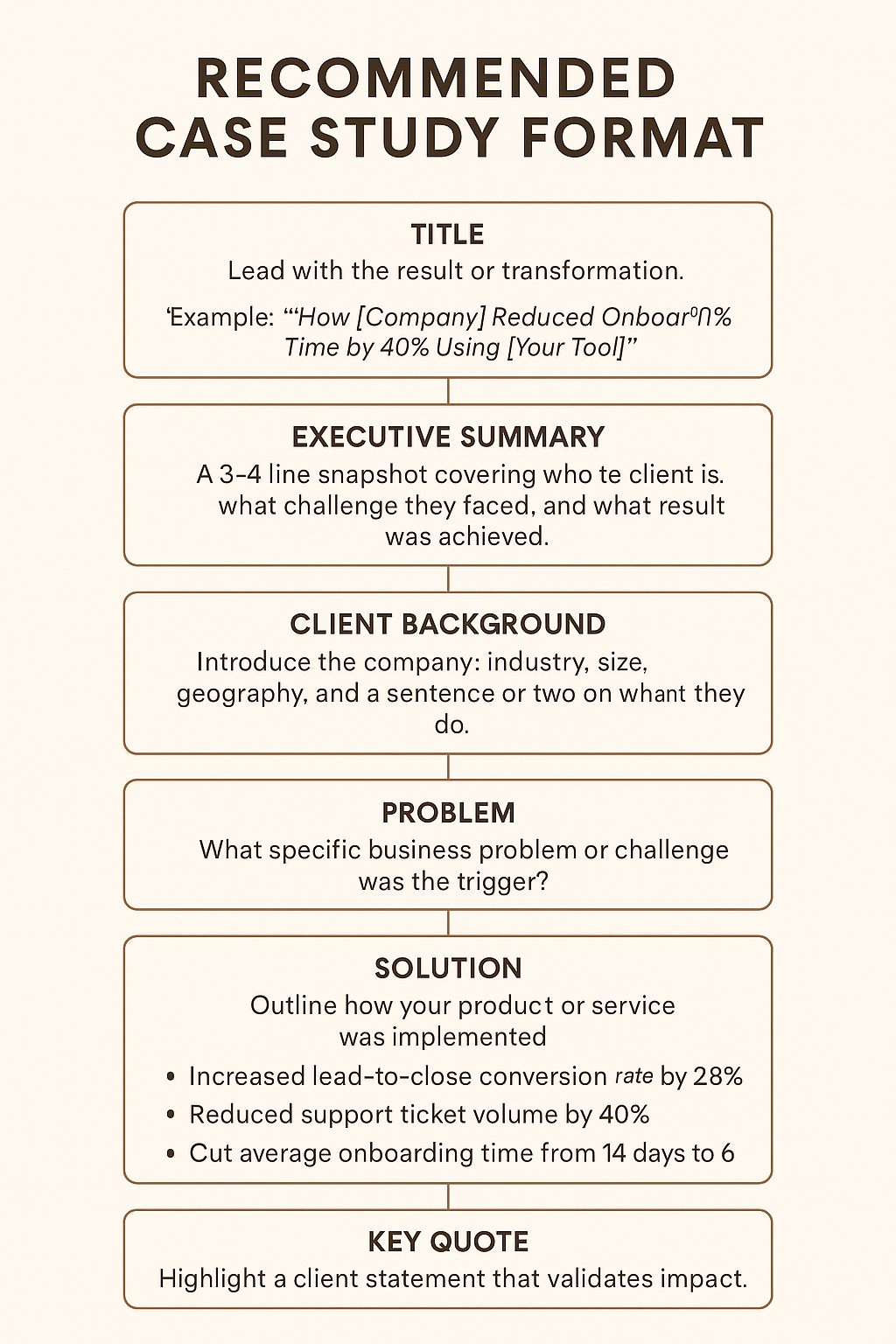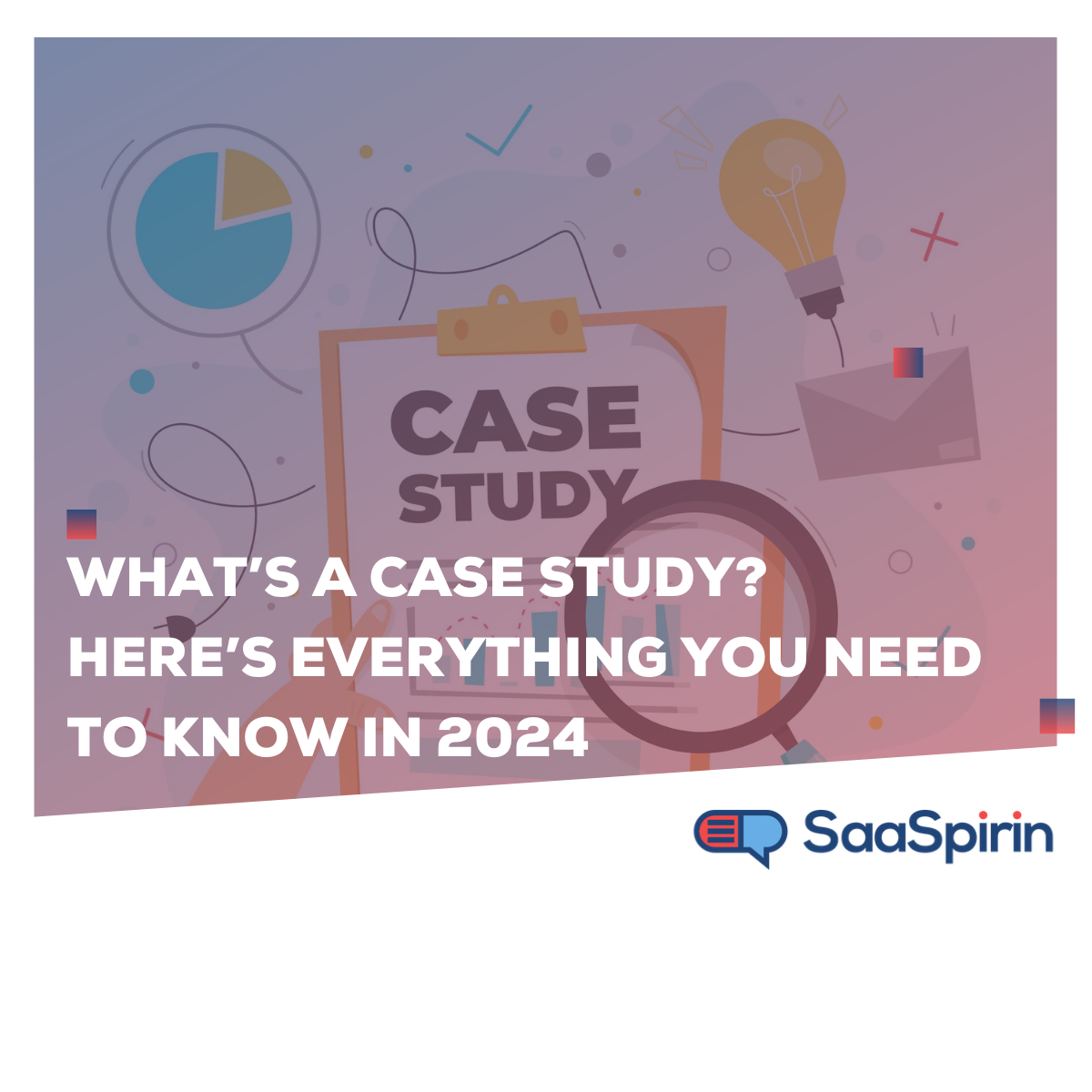How to Write a Case Study That Cut Churn and Boost Trust?
By Nicolas Jacobeus on April 15, 2025
In B2B SaaS, nothing builds trust faster than showing how your product solved a real problem for a real company, with measurable results.
But most teams treat them like blog posts: generic, late-stage, and disconnected from strategy.
If you want to do things differently for your brand, you are in the right place. This blog takes you through how to create case studies that sell—built for pipeline, not pageviews.
What Is a Case Study?
A case study is something your leads can see themselves in. It shows how someone with similar goals, pain points, and constraints solved a real business problem using your product.
In B2B SaaS, case studies are one of the few content types that combine credibility, relevance, and measurable outcomes in a single asset.
They map a clear path: problem → solution → result.
This makes them powerful tools for sales enablement and objection handling, not just content marketing.
Unlike testimonials, which skim the surface, case studies give your audience what they actually care about:
-
The challenge a real customer faced
-
The solution they implemented
-
The impact it had on their business
They also scale. Case studies show up in demo calls, retargeting ads, onboarding emails, outbound sequences, and on high-intent landing pages.
They can take multiple forms:
-
Written reports for SEO and long-form content
-
Branded PDFs for sales teams and follow-ups
-
Short videos for social proof on LinkedIn
-
Quote cards and slides for outbound messaging and decks
The right case study answers questions, builds trust, and accelerates decisions—without a pitch.
Why Case Studies Matter in B2B SaaS?
Case studies are important, hands down. But its also optional. That is, if you are ready to take the risk of leaving your leads go unattended.
When we say Social proof drives B2B decisions, here’s what we mean.
-
73% of B2B buyers say case studies influence purchase decisions (Source)
-
88% of marketers rank them as the most effective type of content for lead generation (Source)
-
Teams using case studies in sales cycles report 34% higher conversions on average (Source)
But this isn’t just about numbers. It’s about relevance and trust. Buyers want to see companies like them, solving challenges they face, with clear results. Case studies deliver that.
They also scale. Unlike webinars or product demos, a well-structured case study works across channels—from sales enablement to SEO, from LinkedIn to nurture flows.
Most importantly, they anchor your product in outcomes—not features. That’s what drives action.
How to Identify the Right Customer for a Case Study?
A strong case study starts with the right subject. Not every customer success story is suitable, and forcing the wrong one into a case study format leads to weak narratives and diluted results.
What Makes a Good Case Study Subject?
Start with strategic fit. Choose a customer that reflects the type of buyer you're targeting. Prospects should be able to see themselves in the story—same challenges, same goals, same vertical (if possible).
Next, consider data availability. Can the customer provide specific metrics or business outcomes? General feedback isn’t enough. A case study needs measurable impact—like reduced churn, increased adoption, or shortened deployment time.
Finally, assess buy-in. Will the customer agree to be named, quoted, and featured? Even if you anonymize the company, their willingness to collaborate shapes the quality and speed of production.
How to Secure Participation?
Even happy customers may hesitate to go on record. The key is framing the request around value, clarity, and minimal effort.
Templated Outreach
Keep it brief, direct, and low-friction.
Example:
Hi [Name], we're putting together a short success story highlighting how [Your Product] helped [Company] achieve [Result]. It would involve a quick interview and your review of the final draft. We'd love to showcase your success and give your team visibility across our channels.
Include the benefit for them: brand exposure, co-marketing, and positioning as a leader in their industry.
Objection Handling
Common objections:
-
“We’re too busy.” → Emphasize how little time is needed (15–20 mins interview, we handle the rest).
-
“We can’t share internal data.” → Offer to anonymize or focus on qualitative outcomes.
-
“We’re not sure legal will allow it.” → Offer pre-approved templates or NDA coverage.
Value Framing
Position the case study as a collaborative win:
-
"Your success can inspire others in the space."
-
"This is a chance to highlight your innovation."
-
"You'll receive the final version before anything is published."
You’re not asking for a favor. You’re offering a platform.
Here are some strategic ways to ask for a testimonial.
How to Structure a Case Study That Gets Read?
Structure matters. B2B buyers scan for relevance and results.
A case study that isn’t immediately digestible will get skipped—regardless of how good the story is.
Use a repeatable format that makes value easy to extract.
Recommended Case Study Format
Here is an illustration of a sample template for your next case study.

Visual Assets to Include
Strong visuals increase retention and comprehension. Include:
-
Data visuals: Line charts, bar graphs, or KPIs to show change over time
-
Pull quotes: Design quotes with emphasis to draw attention
-
Branded visuals: Consistent color, logo, and layout reinforce professionalism
-
Downloadable PDFs: Useful for sales follow-ups or LinkedIn sharing
-
Social snippets: Pre-formatted graphics for quick promotion
The goal is to make the case study both informative and shareable. Treat it like a conversion tool—not a blog post.
What are the 5 Tips to Write Case Studies That Deliver Business Value?
Most case studies fail because they try too hard to sound impressive. What works in B2B is clarity, precision, and relevance.
Here's how to write case studies that do the job:
1. Prioritize Clarity Over Cleverness
This isn’t brand storytelling. It’s proof. Avoid abstract language or overexplaining. Get to the point. Readers should understand the business value in the first few lines of each section.
2. Use Short, Specific Sentences
Long, dense paragraphs lower engagement. Break information into clean, scannable sentences. Replace generalities with specific metrics, outcomes, or processes.
❌ “The client experienced a significant improvement.”
✅ “The churn rate dropped from 8.6% to 4.2% in three months.”
3. Frame the Story With Outcomes First
Don’t bury the impact in the last section. Start strong. Highlight the transformation early—in the title, executive summary, and first paragraph. Prospects want to know if it’s worth reading.
4. Speak to the Prospect’s Problems
Use the case study to mirror real buyer objections. If your audience struggles with long onboarding times, make sure the case study addresses that head-on. Let the customer's journey answer unspoken questions.
5. Avoid Promotional Tones
Your product isn’t the hero—your customer is. Describe what was done and what changed. Let the results speak for themselves. Stick to facts. Avoid phrases like “industry-leading,” “revolutionary,” or “game-changer.”
The 4 Most Avoidable Errors in B2B Case Studies
Even well-intentioned case studies can fall short if they ignore the fundamentals. These mistakes reduce effectiveness and waste internal effort.
1. Overhyping the Brand
A case study is not a product pitch. Avoid turning it into a self-congratulatory narrative. Overuse of marketing language weakens credibility. The goal is to demonstrate value—not declare it.
2. Forgetting to Quantify Impact
Outcomes matter. Without numbers, a case study reads like a blog post. Use hard metrics wherever possible: cost savings, time reductions, conversion improvements, or performance benchmarks. If precise numbers aren't available, use ranges or percentages.
3. Writing Without a Strategic Goal
Case studies must align with a sales or marketing objective—whether it's handling objections, nurturing a specific ICP, or enabling outbound. Don’t create them in isolation. Tie every story to a defined conversion or distribution point.
4. Neglecting Layout and Shareability
Dense paragraphs, weak headings, and missing visuals reduce usability. Break content into logical sections. Use branded visuals, pull quotes, and downloadable formats that make it easy for teams to distribute and for prospects to absorb quickly.
How SaaSpirin Helped Amoobi Turn a Client Win into a Scalable Sales Asset
Amoobi, a retail technology company, helped Leroy Merlin, a leading European home improvement retailer, optimize in-store shopper journeys by using behavioral data.
But the story was stuck in spreadsheets and internal decks, limiting its impact on sales conversations.
The Challenge
Amoobi needed a way to package this story for decision-makers in enterprise retail. Their internal team didn’t have the time or resources to produce high-quality, scalable content assets.
That’s where SaaSpirin did things differently—with a structured, end-to-end approach designed to turn complex outcomes into conversion-ready assets.
What SaaSpirin Delivered
Working directly with Amoobi and Leroy Merlin, SaaSpirin handled everything from stakeholder interviews to final production. The result was a full suite of sales-ready content:
-
Video Testimonial: Featuring Leroy Merlin’s National Sales Manager
-
Written Case Study: Structured for both SEO and sales enablement
-
Branded PDF: Shareable, scannable, and ready for sales decks
-
Quote Cards & Snippets: Designed for LinkedIn and outbound messaging
-
Sales Slide: Condensed proof of value for enterprise pitches
The Business Impact
Amoobi walked away with more than a case study. They gained a library of conversion assets that helped future prospects see proof, without needing a demo. The Leroy Merlin case now works across campaigns, outreach, and sales meetings as a credibility anchor.
Your best proof already exists—it just isn’t documented. We specialize in turning customer outcomes into high-conversion case studies used across sales, marketing, and onboarding.
👉 [Start your case study →]
Conclusion
In B2B SaaS, case studies are not just proof—they’re leverage. Done well, they align sales, marketing, and customer success around one outcome: showing real value to future buyers.
But effective case studies require more than a good story. They need structure, data, clarity, and distribution. When these elements come together, a single customer win can drive measurable revenue impact—across demos, outbound campaigns, and conversion funnels.
If you're sitting on success stories that aren’t being used—or struggling to turn them into usable assets—you're not alone. But you're also leaving deal velocity, credibility, and brand trust on the table.
Case studies don’t just tell what you do. They show what works.
Frequently Asked Questions
1. How to write a case study that addresses key problems effectively?
To write a case study that resonates, start by identifying the key problems your customer faced. Build your content around how your specific product solved these challenges, using a clear narrative form. Always quantify results to show impact.
2. How to format a case study for maximum engagement on social media?
Formatting a case study for social media means distilling complex stories into simple, shareable insights. Use quote cards, short testimonials, and key metrics. Many marketers rely on case study templates to keep formatting consistent across platforms.
3. How to do a case study when you can't reveal the customer’s name?
You can still create a great case study without naming the customer. Focus on the industry, company size, and problem type. For example: “A global logistics firm reduced churn by 28% using [Product].” Anonymized case study content can still convert new customers.
4. How to create a case study that supports product-specific marketing?
When you create a case study around a specific product or feature, focus the narrative form tightly on that use case. Describe the challenge, the decision-making process, and measurable improvements. This works well for sales enablement and onboarding content.
5. How to make a case study stand out from generic content?
The best case studies avoid generic praise and highlight tangible transformation. Use data, a clear structure, and a compelling story. Case studies that follow a real customer journey are more likely to attract and convert new customers than promotional blog posts.
You May Also Like
These Related Stories
How to Do a Case Study When You’ve Never Written One?

What’s a Case Study? Here’s Everything You Need to Know in 2025

